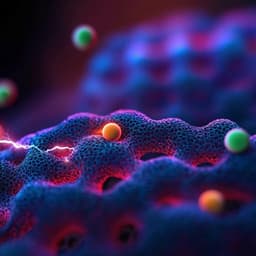
Engineering and Technology
Nanotransistor-based gas sensing with record-high sensitivity enabled by electron trapping effect in nanoparticles
Q. Hu, P. Solomon, et al.
Discover the groundbreaking research by Qitao Hu, Paul Solomon, Lars Österlund, and Zhen Zhang on ultra-sensitive, low-power H₂ gas sensors using nanoscale FETs with Pd nanoparticles. Their innovative approach achieves record-high responses and low detection limits, revolutionizing gas sensing technology.
~3 min • Beginner • English
Introduction
Hydrogen is a key clean-energy carrier but poses safety risks due to its small molecule size, lack of color and odor, low ignition temperature, and wide explosive limits. This creates a need for highly sensitive, fast, low-power H2 leak detection well below explosion thresholds and suitable for distributed monitoring. Pd nanoparticle (PdNP) functionalized FET sensors are promising because Pd catalyzes H2 dissociation and absorption, yielding a work function shift that can modulate a transistor channel, with benefits including current amplification, CMOS compatibility, miniaturization, and room-temperature operation. However, in conventional designs the PdNPs are electrically floating and lie outside the primary gate–channel loop, so their H2-induced work-function change couples only weakly to the channel via stray capacitance. Even with device designs that reduce the sensing-layer–channel distance (ultrathin planar channels or nanowires with side gates), the fundamental indirect capacitive coupling persists, limiting transduction efficiency and sensitivity. This work addresses that core limitation by enabling direct electronic communication between PdNPs and the active channel via electron tunneling and trapping/de-trapping, to realize supersensitive, low-power H2 sensing.
Literature Review
Prior H2 FET sensors using Pd or Pd-alloys on silicon nanostructures, carbon nanotubes, graphene, and other semiconductors exploit Pd’s reversible hydride formation to modulate the channel via work-function changes. Conventional back-gated FETs form the main channel away from the PdNP-functionalized surface, so PdNPs couple only through small stray capacitances, diluting the response in the dominant channel region. Device innovations such as ultrathin silicon channels, nanomeshes, and side-gated nanowires improved geometric coupling but still left the PdNP sensing layer outside the main gate–channel loop, maintaining indirect capacitive transduction and limiting sensitivity. The literature also documents room-temperature operation, low-power targets, and strategies to improve selectivity (e.g., alloying, filters), yet direct coupling of the sensing work-function change to the primary channel remained unresolved.
Methodology
Device concept and structure: A silicon nanowire (SiNW) FET gated via nanoscale air gaps (NAGs) with two NiSi side gates (SINW-NAG FET) was fabricated on SOI. The SiNW channel is p-type with a 600 nm lightly doped region between heavily p-doped source/drain. Side gates are positioned with ~50 nm air gaps to the SiNW sidewalls, creating strong gate coupling to channels that form along the sidewalls. An ultrathin SiO2 passivation layer (2 or 4 nm via ALD) coats the SiNW, and Pd nanoparticles (formed by evaporating <1 nm Pd, yielding agglomerated 2–3 nm PdNPs) are deposited on the top and sidewalls through double-angled evaporation to place PdNPs within the side-gate–channel coupling loop and accessible through the air gaps.
Operating principle: For 4 nm SiO2, the H2-induced PdNP work-function shift couples capacitively to the channel via the NAG capacitance, improving over back-gated controls but still indirectly. For 2 nm SiO2, electrons can tunnel between the channel and PdNPs. Due to Coulomb blockade, each PdNP traps at most one electron, forming discrete energy states that collectively create a distributed trap spectrum dependent on NP size. In air, PdNPs with energy below the channel Fermi level capture electrons, adding a large effective capacitance (C_PdNP) in parallel with the channel (estimated ~20× C_si based on subthreshold-slope changes). Upon H2 exposure, PdNP energy levels rise (work-function shift), releasing trapped electrons back to the channel (de-trapping) until a new equilibrium forms, directly modulating channel carrier density.
Measurements: Devices were tested at room temperature in a controlled gas chamber with synthetic air (O2:N2=1:4), total flow 500 sccm. Analyte gases (H2, CO, NO2, NH3) were introduced via mass-flow controllers from certified sources and diluted to target concentrations (1–1000 ppm H2; 50 ppm CO; 10 ppm NO2; 50 ppm NH3). Electrical characterization used V_D=1 V with gate bias set to stabilize I_DS ≈ 300 nA (≈300 nW power). Real-time current, transfer (I_DS–V_G), output (I_DS–V_D), and low-frequency noise (PSD) were recorded. Control back-gated SiNW FETs with PdNPs only on the top surface (no side gates) were fabricated in parallel. TCAD Sentaurus simulations modeled electrostatics and transport, including mobility, bandgap narrowing, and SRH recombination, and aided in analyzing capacitive coupling loops and channel formation.
Fabrication details: Starting from 100 mm SOI (top Si 55 nm over 145 nm BOX), the Si layer was thinned to ~30 nm by oxidation and oxide strip. BF2 implant formed p+ source/drain and side-gate regions; channel protected by e-beam resist. Dopant activation used rapid thermal processing (1000 °C, 10 s). SiNWs, S/D contacts, and side gates were patterned by EBL with HSQ and defined by RIE. After piranha clean, SiO2 passivation was deposited by ALD (2 or 4 nm). NiSi (20 nm) was formed on S/D and gates by rapid anneal at 400 °C. PdNPs were deposited by e-beam evaporation at 0.1 Å/s to 5 Å nominal thickness with the substrate tilted at 60° for double-angle coverage of the sidewalls. Back-gate control devices omitted side-gates and used non-tilted Pd deposition so PdNPs decorated only the top surface.
Analysis and extraction: Subthreshold slope (SS) degradation, comparison with PdNP-free devices, and increased low-frequency noise in 2 nm oxide devices confirmed PdNP electron trapping accessible by tunneling. The density of PdNP states near the channel Fermi level N_PdNP was inferred from SS versus current, showing a non-uniform, approximately Gaussian energy distribution consistent with NP size dispersion. Shifts in transfer characteristics under H2 quantified the upward energy shift of PdNP states (ΔE_PdNP), comparable to literature. Response metrics included percent resistance change ΔR/R0, sensitivity (%/ppm), response (t90) and recovery (τ50) times, detection limit, and selectivity against CO, NO2, and NH3.
Key Findings
- Direct electron tunneling enables equilibration between the SiNW channel and PdNPs; H2 reaction shifts PdNP energy, driving electron de-trapping to the channel and yielding strong signal transduction.
- Record-high H2 responses from 1 to 1000 ppm at room temperature with ultra-low power consumption (~300 nW). Sensitivity reaches ~3600%/ppm with a lower limit of detection (LOD) of 4.4 ppb (2 nm SiO2 device).
- Compared with a traditional back-gate FET (PdNPs floating outside the main gate–channel loop), the SINW-NAG FET (4 nm SiO2) shows markedly improved sensitivity: 1.71%/ppm vs 0.035%/ppm, and extrapolated LOD 2.7 ppm vs 48 ppm, validating superior capacitive coupling via side gates.
- For 2 nm SiO2 devices, subthreshold slope degradation and elevated low-frequency noise in air (reduced in H2) identify PdNPs as active electron traps; the equivalent PdNP capacitance is estimated ~20× the channel capacitance.
- Transfer-curve analysis indicates the PdNP density-of-states near the Fermi level increases at lower channel current, consistent with a Gaussian-like energy distribution due to nanoparticle size dispersion. Exposure to 10 ppm H2 shifts the PdNP energy distribution upward by ~120–131 mV.
- Kinetics: Response time (t90) and recovery time (τ50) are not degraded by the tunneling-based mechanism relative to 4 nm devices; longer response at lower H2 concentration is attributed to the low H2 sticking probability on Pd.
- Selectivity: Strong response to H2 while responses to 50 ppm CO (neutral), 10 ppm NO2 (electrophilic), and 50 ppm NH3 (nucleophilic) are much smaller (NO2 can produce opposite current sign; NH3 yields a far weaker dipole-induced work-function change under the tested conditions).
- Benchmarking shows the demonstrated responses exceed those of other room-temperature FET H2 sensors using Pd/Pd-alloys on silicon nanomesh, electrostatically formed SiNWs, attached side-gate SiNWs, sub-5 nm Si channels, carbon nanotubes, and graphene over 1–1000 ppm.
Discussion
The work resolves the intrinsic limitation of weak, indirect capacitive coupling in PdNP-functionalized FET H2 sensors by engineering direct electronic communication between the sensing nanoparticles and the main conducting channel. Placing PdNPs within the side-gate–channel loop and using an ultrathin passivation oxide allows electron tunneling and trapping/de-trapping, so that PdNP–H2 reaction directly perturbs the channel Fermi level. This avoids signal dilution from insensitive channel regions and maximizes transduction efficiency, yielding unprecedented sensitivity and ppb-level detection at room temperature with nanowatt power. The experimentally observed transfer-curve shifts, subthreshold-slope behavior, noise signatures, and extracted PdNP energy shifts quantitatively support the proposed mechanism. The approach is general: any sensing nanoparticle whose work function shifts upon exposure to a target gas (e.g., Au for ozone, SnO2 for NO2) could employ the same tunneling-mediated equilibration to achieve ultrasensitive detection. In addition, the kinetics are governed by surface reaction rather than tunneling, preserving fast response and recovery while enabling further acceleration via thermal management.
Conclusion
A CMOS-compatible SiNW side-gated FET with nanoscale air gaps and Pd nanoparticle decoration achieves supersensitive room-temperature H2 sensing by leveraging electron tunneling and trapping/de-trapping between the channel and nanoparticles. This direct coupling mechanism delivers record responses from 1–1000 ppm, sensitivity ~3600%/ppm, LOD 4.4 ppb, and ~300 nW power consumption, while maintaining favorable kinetics and demonstrating selectivity against CO, NO2, and NH3. The concept is extensible to other gases by selecting nanoparticles with gas-dependent work-function shifts. Future work should address long-term stability (e.g., protective polymer layers), environmental robustness across temperature and humidity, strategies to mitigate cross-interferences (e.g., alloying, filters), and on-chip thermal elements to accelerate response and recovery.
Limitations
- Long-term stability under realistic environmental conditions (temperature, humidity) is not fully established; protective coatings (e.g., polymers) may be required.
- Cross-interference from other gases, while reduced, is not eliminated; additional mitigation (NP alloying, filtering films) may be necessary for specific applications.
- Response time increases at very low H2 concentrations due to Pd’s low sticking probability; thermal assistance (micro-heaters, self-heating via suspension) may be needed for rapid kinetics in some use cases.
- The tunneling-enabled trap mechanism introduces additional low-frequency noise in air (though reduced in H2), which could impact ultra-low-signal operation without averaging or filtering.
Related Publications
Explore these studies to deepen your understanding of the subject.







